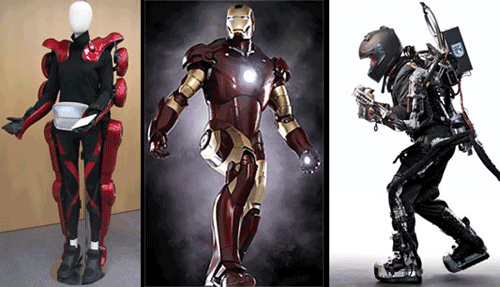A closer look at the plausibility of “far-fetched” technology in popular films
BY BEN STRACK
Motion pictures have greatly evolved since their beginnings. Nowadays, the special effects and technology displayed in many popular films seem unreal! But are they actually? Let’s take a look.
Iron Man
In this popular superhero saga, Tony Stark, a self-proclaimed genius billionaire playboy philanthropist, uses his vast engineering skills to build a suit of armor that gives him protection, added strength, and the ability to fly. As much as the dazzling effects in the film depict the technology as beyond our capabilities, don’t be so sure.


Iron Man’s flying (first picture) challenged by Dan Schlund (second picture), pilot of the Rocketbelt, who soars high above the audience.
The idea of a humans flying as free as a bird started early in the twentieth century, and the technology for it sprouted in the 1960s. Many engineers and inventors have tried to build jetpacks and rocket belts to lift them off the ground, but as you might have guessed, nobody has come close to the speed, maneuverability, and style of Iron Man.
Great strides have, however, been made in the jetpack industry. Perhaps the most successful machine of its kind is the Rocketbelt from Powerhouse Productions, which is used mostly for entertainment purposes, and excites crowds with its height, speed, and length of travel. The machine, flown by Dan Schlund flies for a maximum of thirty seconds, and in that time travels a distance of 150 to 200 meters at 20 to 25 meters in the air. Superheated steam and an oxygen by-product are needed for the Rocketbelt’s 800-horse power thrust to keep it in the air that long.
In terms of Iron Man’s suit of armor, exoskeletons have been developed for added strength for its user. The Sarcos XOS exoskeleton samples the user’s muscle movements thousands of times per second and a built-in computer analyzes the data to enhance the user’s strength vis-á-vis the exoskeleton.
Another model, Japan’s HAL exoskeleton — which stands for “hybrid assistive limb” — senses muscle movements through electrical signal flows on the skin surface. It then translates the nerve signals into signals that control electric motors for the knees and hips of the exoskeleton to amplify the user’s strength tenfold.

The HAL exoskeleton (left), Iron Man (middle), and the Sarcos XOS exoskeleton (right) share the ability of enhancing strength despite different appearances.
The Abyss
In this 1989 James Cameron film, a character uses liquid breathing to dive thousands of feet without feeling the effects of compression. In another scene, a rat is fully submerged in a fluorocarbon liquid, keeping it from drowning.
As crazy as this may sound, not only is this “breathable liquid” possible, but it already exists. In fact, the rat scene was filmed with a real rat in actual oxygenated liquid.

A rat is able to breathe when placed in an oxygen-rich liquid to the amazement of the witnesses.
Liquid breathing is a type of respiration in which air-breathing organisms can breathe an oxygen-rich liquid (such as a perfluorocarbon) instead of air. The technique is still in experimental stages, but is thought to be useful in a few different areas of practice, including diving, space travel, and medical treatment.
In theory, during an actual dive, liquid in the lungs would better accommodate changes in pressure of the surrounding water than when the lungs are filled with gas. Unlike using high-pressure nitrogen or helium, liquid breathing does not saturate body tissues, thereby allowing divers to quicken their rate of decompression. This is due to the high resistance of the liquid, which reduces its ability to remove CO2 . It can be harmful to the body, and must be remedied before divers can actually use the liquid breathing technique.
Liquid breathing is also being tested for space travel. The United States Air Force is considering the adoption of suits that immerse the user in a rigid uniform filled entirely with the liquid as a means for reducing the physical stress of G forces experienced in space.
In the 1990s, the technique was used on premature babies with acute respiratory distress syndrome. Furthermore, it has been found that perfluorocarbons reduce lung inflammation. So it may very well be the case that the most useful adoptions for liquid breathing might be found in medical treatment.
Batman Begins / The Dark Knight
In Christopher Nolan’s Batman trilogy, it seems Bruce Wayne is given all the gear he could ever need with the help of billions of dollars and a very intelligent Morgan Freeman. A few of his highlight “toys” include a memory fiber cape, grapple gun, and of course the sleek, yet lethal, Batmobile.
Starting with the memory fiber cape, the garment becomes a rigid set of bat-like wings when charged with an electric current — essentially converting it into a glider. Made from parachute-grade nylon, Christian Bale’s cape was in fact electrically charged using electrostatic flocking — a technique used for military and police gear.


Batman’s rigid cape gives him the appearance of a bat, also paying resemblance to a hang glider.
Batman also uses a grapple gun to make up for the lack of webs flying out of his wrists. In our world, we have grappling-hook launchers, but none as small and compact as the Dark Knight’s. Swinging from buildings would require thick cables, which can only be stored in larger spaces, making it less practical to be strapped to one’s belt.

The Batmobile’s sleek design and advanced capabilities make it one of the most popular fictional vehicles ever conceptualized.
And who could forget the beloved Batmobile? Designed as a mix between a Lamborghini and a tank in the most recent films, this vehicle includes armored exterior, a jet engine, and rocket launchers, just to name a few. Of course, the Batmobile would be illegal on the streets of our Gotham cities, but could we recreate it?
For starters, the body of the car was designed and built by the production design crew, so despite plenty of special effects, this vehicle does actually exist. In fact, they built four of these street-ready cars, each armored with 65 carbon fiber panels and costing $250,000 to make. Other strides in armoring vehicles on a commercial scale come from IAC’s Armormax, whose goal is to make cars bulletproof.
Of course rocket launchers and auto cannons exist and can be seen on military tanks. Because of the heavy artillery and armor, however, these tanks cannot speed through city streets at over 100mph, make sharp turns, or perform “ramp-less” jumps. This is where we must accept that a vehicle like the Batmobile is a bit too grandiose of a project for our current capabilities.
Ocean’s Thirteen
In the third installment of this popular caper-movie franchise, Ocean’s Thirteen gives us a glimpse of security measures taken by casinos to separate the cheaters from the gamblers. Specifically, the movie highlights a technology called “The Greco Player Tracker,” which measures a person’s heart rate, body temperature, and pupil dilation to decide whether a win is legitimate or expected. The information received by the Tracker is said to analyze the data it collects in a field of exabytes (one exabyte = one million terabytes) to determine if the casino has a winner or a cheater on its hands.
But, has this Hollywood technology made its way to Vegas?
For the cheaters out there, have no worries; the answer is no. But, could it exist? Measuring pupil dilation and body temperature would be possible with high-resolution cameras and wireless optical thermometers, but measuring heart rate using a camera (without physical contact with the person) is not very plausible. Maybe a gambler’s heartbeat could be determined with advanced microphones on the camera, but not in a crowded, noisy casino.
Furthermore, when it comes to storing exabytes, yes, there are file systems that support one exabyte of information; however, a method for analyzing data within a field of many exabytes as quickly as they describe in the movie has not yet been proven.

Looks like the boys are still in business.
Check back for future articles about technology in more of your favorite films! ■
Advertisement
Learn more about Electronic Products Magazine





